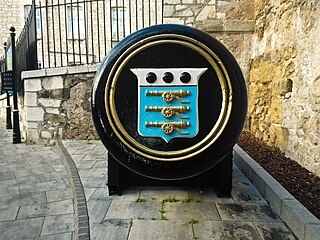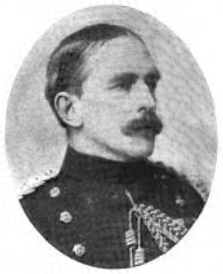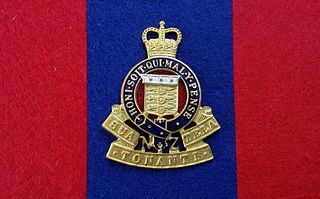
The Board of Ordnance was a British government body. Established in the Tudor period, it had its headquarters in the Tower of London. Its primary responsibilities were 'to act as custodian of the lands, depots and forts required for the defence of the realm and its overseas possessions, and as the supplier of munitions and equipment to both the Army and the Navy'. The Board also maintained and directed the Artillery and Engineer corps, which it founded in the 18th century. By the 19th century, the Board of Ordnance was second in size only to HM Treasury among government departments. The Board lasted until 1855, at which point it was disbanded.
Commissar is an English transliteration of the Russian комиссáр (komissar), which means 'commissary'. In English, the transliteration commissar often refers specifically to the political commissars of Soviet and Eastern-bloc armies or to the people's commissars, while administrative officers are called commissaries.
Company quartermaster sergeant is a military rank or appointment.

Joseph Trumbull, son of Governor Jonathan Trumbull of Connecticut, was the first commissary general of the Continental Army during the American Revolutionary War.
A commissary is a government official charged with oversight or an ecclesiastical official who exercises in special circumstances the jurisdiction of a bishop.

The Royal Army Service Corps (RASC) was a corps of the British Army responsible for land, coastal and lake transport, air despatch, barracks administration, the Army Fire Service, staffing headquarters' units, supply of food, water, fuel and domestic materials such as clothing, furniture and stationery and the supply of technical and military equipment. In 1965 its functions were divided between other Corps and the RASC ceased to exist; subsequently, in 1993, they in their turn became the "Forming Corps" of the Royal Logistic Corps.

The Royal Army Ordnance Corps (RAOC) was a corps of the British Army. At its renaming as a Royal Corps in 1918 it was both a supply and repair corps. In the supply area it had responsibility for weapons, armoured vehicles and other military equipment, ammunition and clothing and certain minor functions such as laundry, mobile baths and photography. The RAOC was also responsible for a major element of the repair of Army equipment. In 1942 the latter function was transferred to the Royal Electrical and Mechanical Engineers (REME) and the vehicle storage and spares responsibilities of the Royal Army Service Corps were in turn passed over to the RAOC. The RAOC retained repair responsibilities for ammunition, clothing and certain ranges of general stores. In 1964 the McLeod Reorganisation of Army Logistics resulted in the RAOC absorbing petroleum, rations and accommodation stores functions from the Royal Army Service Corps as well as the Army Fire Service, barrack services, sponsorship of NAAFI (EFI) and the management of staff clerks from the same Corps. On 5 April 1993, the RAOC was one of the corps that amalgamated to form The Royal Logistic Corps (RLC).
The U.S. Army was founded on 14 June 1775, when the Continental Congress authorized enlistment of riflemen to serve the United Colonies for one year.

Foods of the American Civil War were the provisions during the American Civil War with which both the Union and Confederate armies struggled to keep their soldiers provisioned adequately.

Colonel Sir Edward Willis Duncan Ward, 1st Baronet, was a British Army officer and military administrator, serving as Permanent Secretary of the War Office. He was a notable reformer of army administration, improving efficiency of mobilization, medical services and supplies.

A military commissariat, is an institution that is part of military service or law enforcement mechanisms in some European countries. As part of the British Army in the 19th century, military commissariats were used for organisational, accounting and bookkeeping duties regarding military transport, personnel and equipment. The most widespread historic use of military commissariats existed as part of administrative military infrastructure in the Soviet Union. Each Soviet district would have a military commissariat that was responsible for keeping documentation up to date concerning military resources, including the labour force, in their region. Military commissariats in the Soviet Union were also tasked with the recruitment and training of military servicemen. The use of military commissariats as local military administrative agencies continued as a part of modern Russia after the dissolution of the Soviet Union in 1991. There has been criticism and speculation regarding corruption in the recruitment process of military personnel and allegations of an abusive military culture in commissariats since their inception. This has caused the role of military commissariats as administrative agencies to be questioned. Buildings that were military commissariats still serve their purpose in Russia and some other post-Soviet states. In France and Italy, the word "commissariat" can refer to factions of the police and law enforcement, some of whom are connected to the military.

The Transport Board was a British government organisation responsible periodically for the overseas transport of troops and horses, arms and ammunition, naval and military supplies, provisions and other items. It is also referred to as the Board of Transport and the Transport Office.

The Indian Army Service Corps (IASC) is a corps and an arm of the Indian Army which handles its logistic support function. It is the oldest and the largest administrative service in the Indian Army. While the history of supply and transport services is as old as the history of organized warfare itself it was in 1760 that the very rudimentary supply and transport organizations of the three presidencies of the East India Company were brought under the council of a single authority.

The ranks and rank insignia of the Red Army and Red Navy between 1940 and 1943 were characterised by continuing reforms to the Soviet armed forces in the period immediately before Operation Barbarossa and the war of national survival following it. The Soviet suspicion of rank and rank badges as a bourgeois institution remained, but the increasing experience of Soviet forces, and the massive increase in manpower all played their part, including the creation of a number of new general officer ranks and the reintroduction of permanent enlisted ranks and ratings.

The Royal New Zealand Army Ordnance Corps (RNZAOC) was a Corps in New Zealand until 1996. It concerned itself with the provisioning of troops with the means to fight; specifically uniforms, weapons and equipment. Ordnance functions go back hundreds of years; the first Ordnance Officer in the British military appeared in the year 1299. Designated "Keeper of the King's Wardrobe", his duties included the care and accounting of heavy equipment such as battering rams and catapults.

The Chief of Ordnance of the United States Army is a general officer who is responsible for the Army Ordnance Corps and serves as the Commandant of the U.S. Army Ordnance School at Fort Lee, Virginia. The Chief of Ordnance is primarily focused on the doctrine, training, and professional development of Ordnance officers and soldiers. The position was created simultaneously with the establishment of the Army Ordnance Department on May 14, 1812.

The Swedish Army Quartermaster Corps was an administrative corps for personnel within the Swedish Army created in 1880. From the corps, the Swedish Army was provided with staff for various commissary positions. The head of the corps was the Quartermaster-General of the Swedish Army. In 1966, the corps was amalgamated with the Swedish Naval Supply Service (Marinintendenturkåren) and the Swedish Air Force's quartermaster officers and formed the Quartermaster Corps of the Swedish Armed Forces. It was in turn amalgamated with the Swedish Army Ordnance Corps in 1973 and formed the Commissary Corps of the Swedish Armed Forces which was disbanded in 1990.
Comptrollers of Army Accounts were British public officials first appointed on 10 June 1703, by the Lord High Treasurer, Lord Godolphin; there were two Comptrollers. Initially under the authority of the Commander-in-Chief, they were instead made accountable to the Treasury in 1708.

The Corps of Royal Artillery Drivers was a British Army corps founded in 1793 and disbanded in 1822. It was established to provide trained and disciplined drivers for the Royal Artillery, a service that had previously relied upon civilian contractors. Though closely associated with the Royal Regiment of Artillery the corps was listed separately from it in the London Gazette until at least 1815. By 1814 the corps numbered more than 7,400 men and fielded more than 2,600 men at the 1815 Battle of Waterloo. The unit was reduced in size after the end of the Napoleonic Wars and disbanded in 1822 by the Duke of Wellington.
The Purveyor of Public Supplies was the government official in charge of most government procurement in the early Republic, including the procurement of all military and naval supplies except food. The office was established in 1795 and superseded by the Commissary General of Purchase in the War Department and the Secretary of the Navy respectively in 1812.













